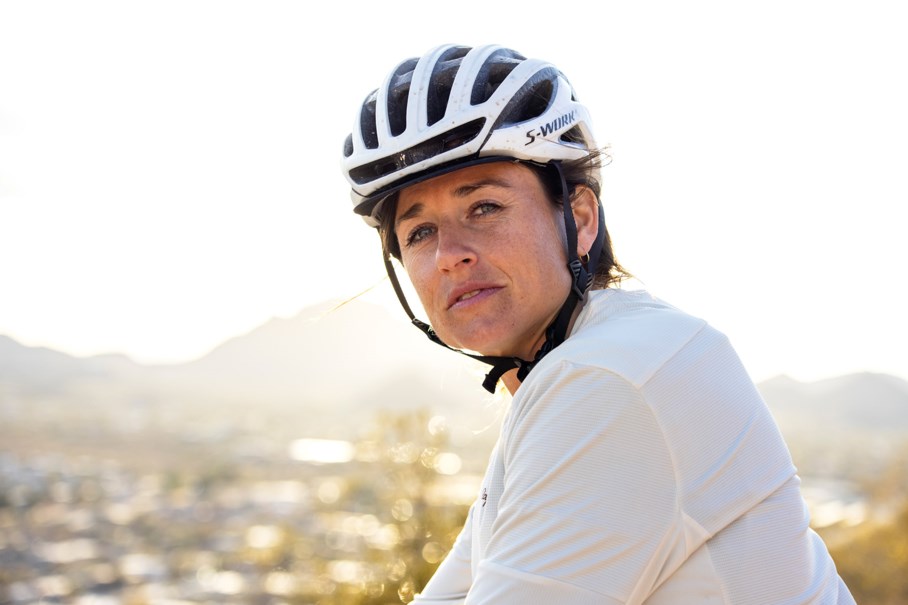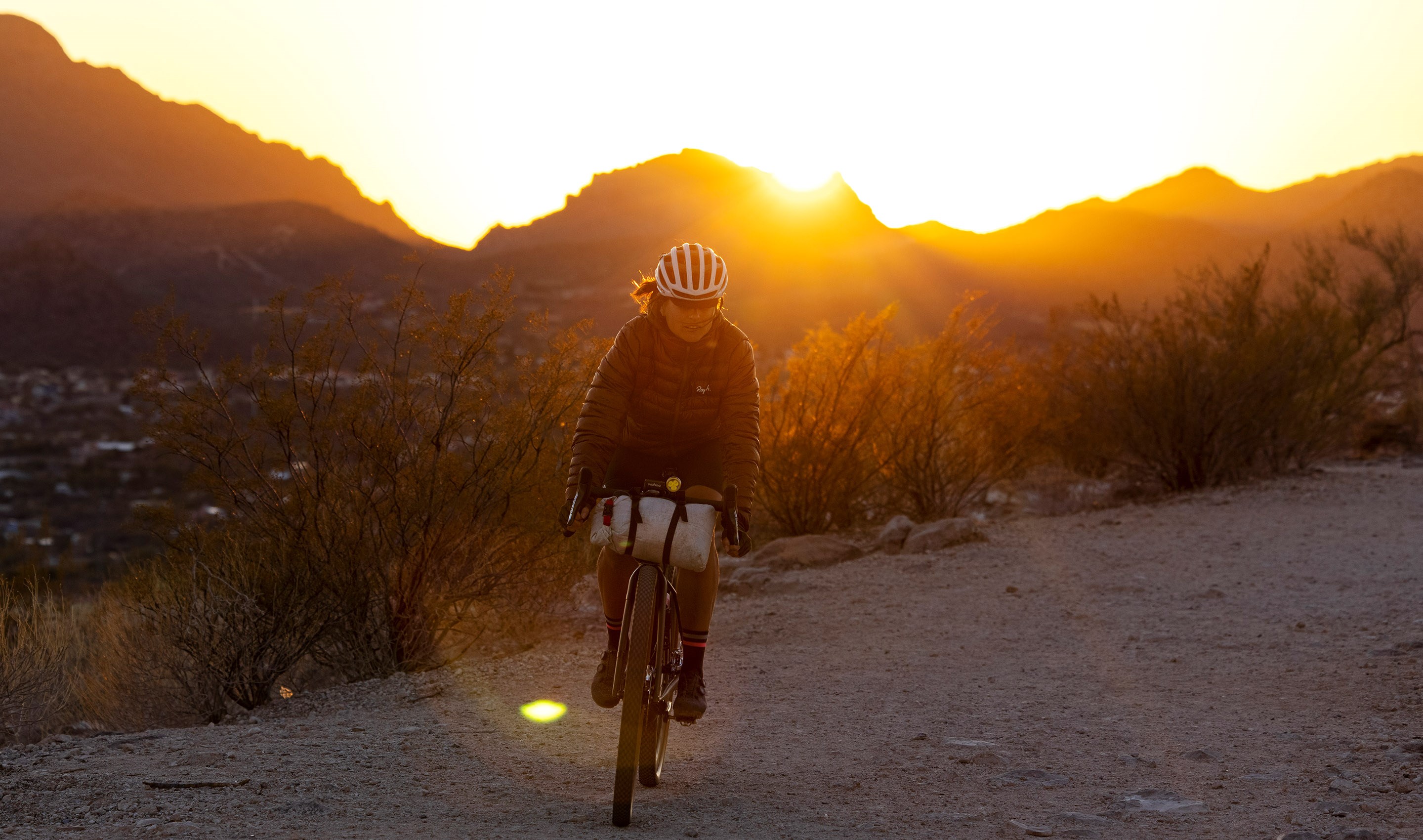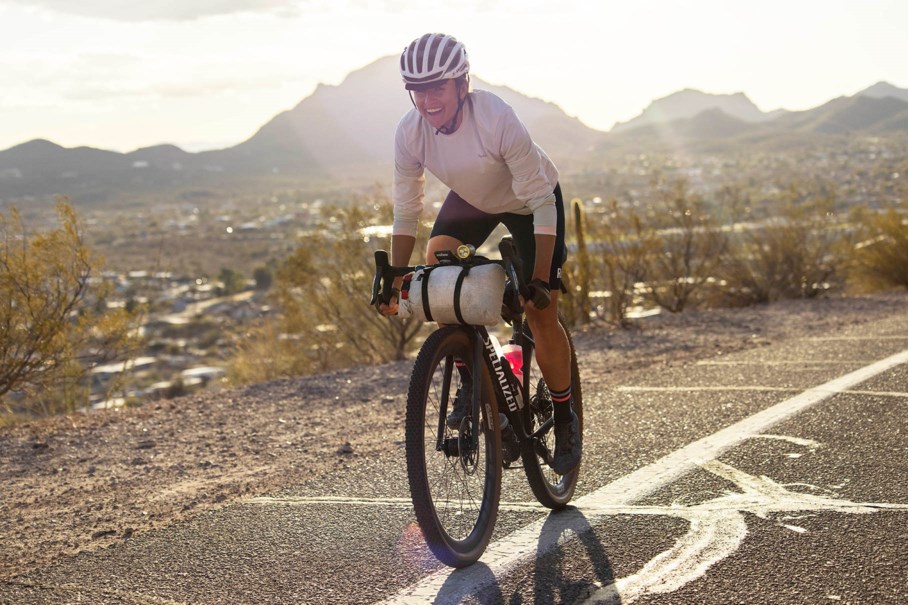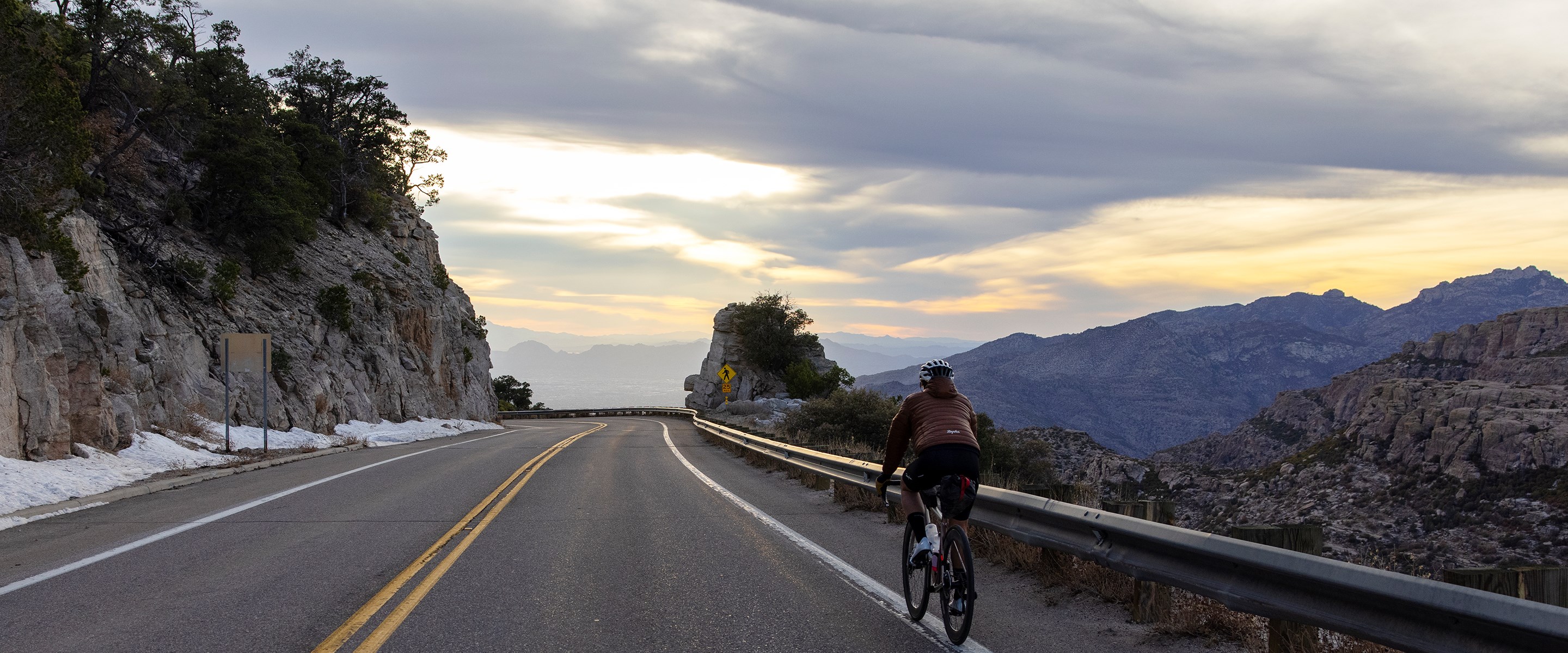RACING THE ENTIRE FIELD
Lael Wilcox
Born and raised in Anchorage, Alaska, Lael Wilcox is an ultra-endurance cyclist. She's inspired to push her own limits, travel the world by bike and encourage other women and girls to get out and ride. For the past three years, she's been riding and traveling with her girlfriend, Rugile Kaladyte, a professional photojournalist.

Nobody wins by accident and it never comes easy.
In 2016, I won the Trans Am Bike Race, a 4,300-mile self-supported race across the U.S. from Oregon to Virginia. I was out there for eighteen days and 10 minutes. I averaged 237 miles per day, crossing eleven states with 217,000 feet of climbing. In a self-supported race, you can’t have a support vehicle or accept any assistance outside of commercial businesses that are available to all racers. You have to find food and water along the way. You decide where and when you’ll sleep. You maintain your bicycle and yourself.
In June of 2016, there was a heatwave across the country. Most days were above 100 degrees and it hit 106 on at least half of them. I tried to keep my body cool by jumping into streams or soaking my clothing from spigots. My skin sunburned so badly that it blistered and peeled off twice. I bought food from gas stations and drank gallons of chocolate milk. For the first week of the race, I floated between fifth and 10th place, a hundred miles behind the leader. I felt frustrated and inadequate. I was trying my hardest. I wanted to win, and I had nothing more to give. I kept going. I rode from the Oregon Coast through the desert into the Rockies, through Yellowstone, and past the Tetons. I didn’t bring a sleeping bag and the nights were freezing. I laid shivering on the ground. I started sleeping in hotels, up to five hours a night. I got stronger. I rode consistently. By the halfway point in Kansas, over two thousand miles into the ride, I was in second or third place.

Fans started meeting me on the roadside in small towns. They told me the leader, Stefan, was asking about me. He was worried I’d catch him. He had stopped sleeping, only catnapping for an hour at a time. I kept at it and hit my stride in the Appalachian Mountains. The punchy, steep climbing suited me. I broke my seat post in Missouri and rode fifty miles standing up to get to a bike shop before closing to replace it. Fifteen days into the race, Stefan was still fifty miles ahead of me as I crossed into Kentucky. I knew I had to cut sleep to catch him. For the final three nights, I slept a total of six hours. My lowest moment was buying multiple cans of Mountain Dew in a whitewashed mercantile in Western Virginia, wishing they had something stronger. I caught Stefan in the middle of the final night in Bumpass, Virginia riding towards me. After a catnap, he woke up disoriented and started riding backward, pedaling ten miles in the wrong direction.
When he saw me, he turned around and rode next to me. I was so out of it, I had no idea who he was. I thought he might be a fan. When I asked his name, he responded with “Stefan” and it clicked. I’d been chasing this guy for seventeen days. I lit up. I started sprinting. We still had 130 miles to go, but I acted like we were rounding the final turn. Hammering the pedals, he rode level with me as I kept going harder and harder, breathing like a train engine. I remember imagining myself passed out on the side of the road and told myself I’d keep going until I dropped. It felt incredible to have legs after so many thousands of miles, exhilarating and exhausting with every beat of my heart.

At a fork in the road, I turned right, and Stefan called out that the route went left. Our course wasn’t marked, and we were following GPS. I got back on track and Stefan slowed for me to catch up.
“Can we talk?”
I really didn’t want to, but since he’d waited, I said, “Yes”.
“We’ve been battling for two weeks. Let’s just finish this race together.”
“Together?! No way! This is the best part, we actually get to race!”
And I meant it. For ultra-endurance racing, you spend so many hours alone with your thoughts. You endure and sacrifice and do everything you can to keep moving forward to the best of your ability. In head-on competition, you get to share terrain and energy. It’s a game that someone wins, and everyone gets to put themselves on the line. It’s unpredictable and that’s part of what makes it exciting.

I took off, sprinting with all of my might. Half an hour later, I realized I had dropped him. With a hundred miles to go, I was obsessed with the finish. Winning finally became real and my eyes stayed on the road, watching for glass, obsessing about mechanicals, riding consistently, eating yogurt-covered pretzels like a machine. Push the pedals, no flat tires, don’t bonk.
Riding past Williamsburg and into Yorktown, the streets were decorated colonial and there were Civil War reenactments— children playing snare drums and flutes. I felt like I was losing my mind. The main road was blocked by construction and I had a weird feeling that it was never going to end. I followed the detour to the Victory Monument where the finish line awaited me. I unclipped at the stone steps.
A small crowd was there to cheer me in. Someone set out a camping chair and passed me a cold Budweiser. I sat down and took off my shoes and told the story about the final night. I waited two hours for Stefan to finish. When he did, he got off his bike, pulled a blueberry muffin out of his bag, and dove headfirst into it. When he finished the muffin, someone handed him another one and he ate that too.

I feel fortunate to be a competitor, to take on ultra-distance self-supported races which exist without gender categories. I always try to win the overall. I don’t always succeed, but when I do, it raises the bar of competition.
We all try harder and that’s really what I’m after— doing my best and seeing where I stack up. Along the way, I get to ride through days and nights, see the world, and learn about myself. The air feels different as you travel through it by bike. It’s fresh and the world feels full of promise. You’re on your own in the middle of it.
Competition is only one facet of cycling— a world of challenge and fun, recreation and transportation, an open space to think and learn. I feel at home on my bike and have found so much confidence by pushing the pedals. I want to share this and get more people on bikes, especially women and girls. I do this through adventure riding scholarships, Anchorage GRIT (my middle school girls cycling mentorship program), and challenges to encourage more women to discover new limits including a bikepacking challenge the first week of August in Colorado.

Could we erase gender categories from bikepacking races? I believe we can and feel strongly about encouraging more women to do their best. Does it really matter? Perhaps, only in the fact that it changes our perceptions of what is possible. I remember feeling so disappointed as a child when I realized that I’d never be able to keep up with the boys. I’m thrilled to have found a sport where I can take anyone head on.

SRAM is proud to donate $5000USD to Yes, You Ride on behalf of Lael, in honor of her piece for International Women’s Day:
“The first week of August 2021 will be the first Yes, You Ride: A bikepacking challenge for All Women: femme, transgender, non-binary, Black, Indigenous, People of Color,” Says Lael. “It will be a group start of 100 women riding a stretch of Adventure Cycling Association's Great Divide Mountain Bike Route from Steamboat Springs to Del Norte, Colorado. We're targeting beginner bikepackers and providing a community that will encourage them to take on the challenge of finishing this ride in a week. It's not a race and it's not easy. It's a true self-supported adventure through a stretch of The Rockies on gravel roads. We're organizing a scholarship fund to help a few riders with gear and financial assistance.”

You can follow Lael @laelwilcox. Photos by Rue Kaladyte.